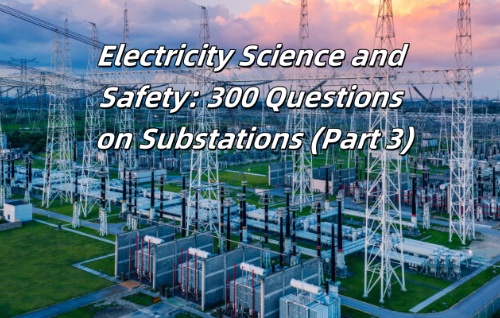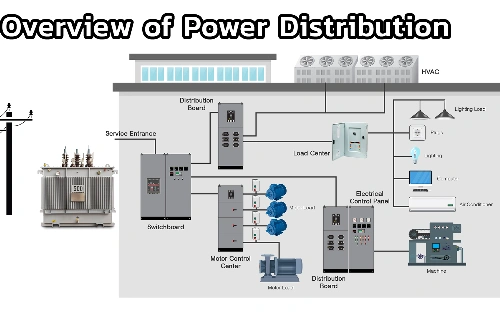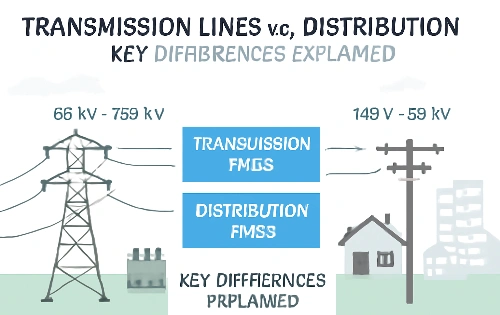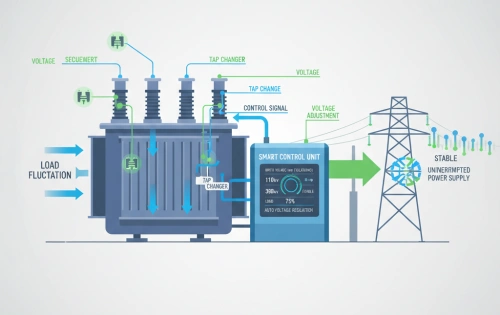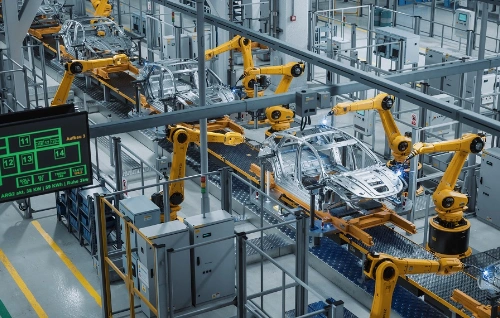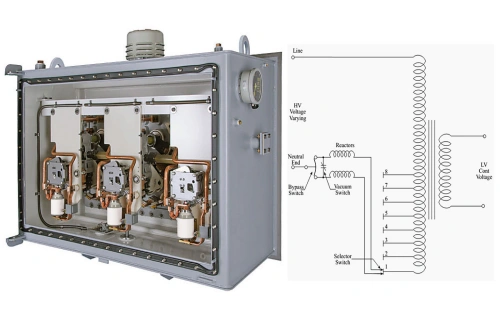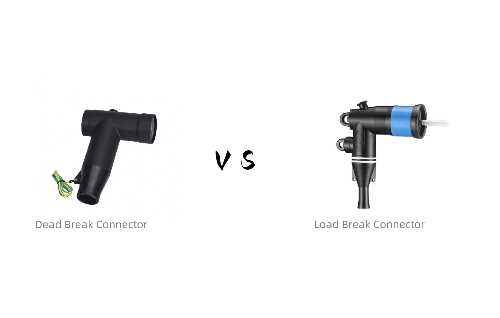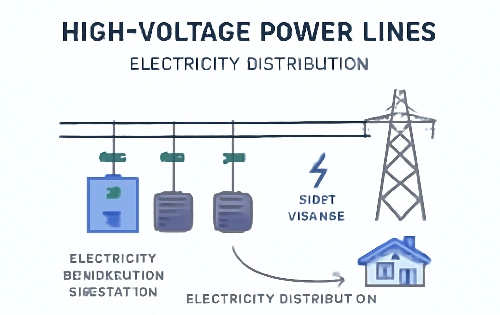Electricity Science and Safety: 300 Questions on Substations (Part 1)
Substations are an extremely important component of the power system and a transportation hub of the power system. They undertake the important tasks of collecting electrical energy, increasing and decreasing voltage, and distributing electricity. They play an important role in the power supply of all walks of life in society. Their safe and stable operation can not only ensure the smooth transmission of power resources, but also ensure people’s normal production and life, create more economic and social value for enterprises, and ensure the safety of people’s lives and property.
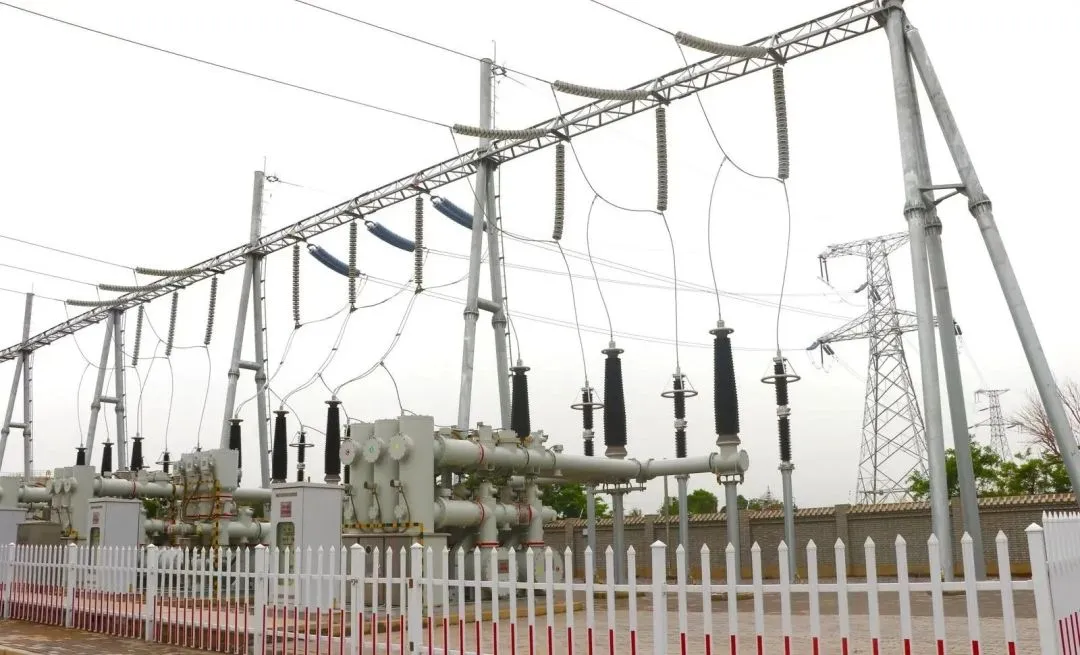
Frequently Asked Questions (FAQ)
1. What is the function of a high-voltage circuit breaker?Answer: High-voltage circuit breakers can not only cut off and connect the no-load current and load current in the high-voltage circuit under normal circumstances, but also cooperate with protection devices and automatic devices when a system fault occurs to quickly cut off the faulty power supply, prevent the accident from expanding, and ensure the safe operation of the system.
2. What are the technical learning contents for operators?
Answer: ( 1 ) Electricity safety work procedures, operating procedures, accident handling procedures, technical grade standards, job specifications, and related regulations and systems. ( 2 ) Accidents, obstacles, equipment abnormality data accumulated over the years and anti-accident technical measures that have occurred in this bureau. ( 3 ) Weak links exposed in anti-accident exercises and anti-accident measures, and countermeasures. ( 4 ) The structure, principle, parameters, performance, system layout and operation methods of current and new equipment. ( 5 ) Safe and economical operation mode and advanced working methods. ( 6 ) Operation mode after equipment maintenance and changes, and operation of new technologies. ( 7 ) The impact of seasonal changes on operating equipment and preventive measures. ( 8 ) Demonstration of operation professional theory or operation skills, etc. ( 9 ) Relevant parts of dispatching regulations3. What is the main function of the transformer in the power system?
Answer: The role of a transformer in a power system is to transform voltage to facilitate power transmission. Boosting the voltage through a step-up transformer reduces line losses, improves the economics of power transmission, and enables long-distance power transmission. A step-down transformer, on the other hand, converts high voltage into the desired voltage levels to meet user needs.4. What are the hazards of casing cracks?
Answer: Cracks in the bushing reduce insulation strength, leading to further insulation damage and even complete breakdown. Freezing water in the cracks can also cause the bushing to rupture. Therefore, bushing cracks pose a significant threat to the safe operation of the transformer.5. What are the main components of an oil-immersed transformer?
Answer: The main components of a transformer are: iron core, winding, oil tank, oil pillow, breather, explosion-proof pipe, radiator, insulating sleeve, tap changer, gas relay, thermometer oil purifier, etc.6. What is the function of the wave arrester?
Answer: The wave arrester is an indispensable high-frequency communication component for carrier communication and high-frequency protection. It prevents high-frequency current from leaking to other branches and reduces high-frequency energy loss.7. What is the use of current transformer?
Answer: Current transformers convert high currents into smaller ones at a specific ratio, providing current for various instruments and relay protection, and isolating the secondary system from high voltages. They not only ensure personal and equipment safety, but also simplify and standardize the manufacture of instruments and relays, improving economic efficiency.
8. What are the wiring methods for current transformers?
Answer: The wiring methods of current transformers include two-phase V- shaped wiring and two-phase current difference wiring using two current transformers; three-phase Y-shaped wiring, three-phase △ -shaped wiring, and zero-sequence wiring using three current transformers.
9. How many types of reactive power sources are there in the power system?
Answer: The reactive power sources in the power system include: synchronous generators; phase regulators; parallel compensation capacitors; series compensation capacitors; static compensators.
10. Why should a set of ZnO lightning arresters be installed between the power capacitor and its circuit breaker?
Answer: Installing ZnO lightning arresters can prevent operational overvoltages that may occur during the opening and closing operations of power capacitors, ensuring the safe operation of electrical equipment.
11. What are the differences between the values indicated by the electricity meter and the power meter?
Answer: The power meter indicates the instantaneous amount of electric power generated, transmitted, and consumed by the power generation, supply, and consumption equipment; while the value of the energy meter is the cumulative amount of electric energy generated, transmitted and consumed over a certain period of time.
12. What are the requirements for parallel battery formation?
Answer: The electromotive force (EMF) of the batteries in a parallel capacitor bank must be equal. Otherwise, the battery with the higher EMF will discharge into the battery with the lower EMF, creating a circulating current within the battery pack. Furthermore, the internal resistance of each battery must be equal. Otherwise, the discharge current of the battery with the lower internal resistance will be too high. Batteries of varying age should not be used in parallel.
13. What is the function of the central signal device?
Answer: The central signal is a signal device that monitors the operation of electrical equipment in substations. It sends out sound and light signals based on the fault characteristics of the electrical equipment to inform the operating personnel to quickly find the fault, make correct judgments and handle the problem, and ensure the safe operation of the equipment.
14. Why is there still power in the cable line for a short period of time when testing with an electrician's tester after a power outage?
Answer: A cable line is like a capacitor. After a power outage, it still has residual charge and a potential difference with the ground. If you test the line immediately after a power outage, a test pen will show that the line is live. Therefore, the grounding wire can only be installed after the line has been fully discharged and tested to be dead.
15. What is internal overvoltage?
A: Internal overvoltages occur when a system's state suddenly changes due to operation, accidents, or other reasons. This transition from one stable state to another can generate dangerous overvoltages. These overvoltages are caused by the oscillation and accumulation of electromagnetic energy within the system, hence the name internal overvoltage.
16. What is the function of the upper equalizing ring of the 220KV valve -type lightning arrester?
Answer: After installing the equalizing ring, the voltage of the lightning arrester is evenly distributed.
17. What is protective earthing? What are its advantages?
A: Protective earthing is a method of directly connecting the metal parts of a device, which are normally not live, to the system neutral line using a conductor. Protective earthing ensures personal safety and prevents electric shock accidents.
18. What is the difference between the neutral point, zero point and zero wire?
A: The common connection point where the beginning (or end) of the three-phase windings are connected is called the neutral point of the power supply. When the neutral point of the power supply has a good connection with the grounding device, this neutral point is called the zero point; and the wire leading from the zero point is called the neutral wire.
19. What role does the DC system play in a substation?
A: The DC system in a substation provides reliable DC power for control, signaling, relay protection, automatic devices, and emergency lighting. It also provides reliable operating power. The reliability of the DC system plays a vital role in the safe operation of the substation and is the guarantee of its safe operation.
20. In order to keep the battery in a fully charged state during normal float charging, what should the terminal voltage of each battery be maintained at?
Answer: In order to keep the battery in a fully charged state, each battery connected to the DC bus must maintain a voltage of 2.15V during float charge.
21. Why is it necessary to install a DC insulation monitoring device?
A: It is not permitted to operate a DC substation system with one pole grounded for extended periods of time. This is because if a second ground fault occurs at another point on the same level, it could cause malfunctions in signaling devices, relay protection, and control circuits. Furthermore, if a second ground fault occurs at another point on the same level while one pole is grounded, a DC short circuit will occur.
22. Explain what floating charge is?
A: Float charging is to install two charging units, one is the main charging unit, and the other is the floating charging unit. Float charging is to compensate for the self-discharge loss of the battery and keep the battery pack in a fully charged state.
23. Why do outdoor busbar joints easily get hot?
A: Outdoor busbars are often exposed to wind, rain, snow, sun, frost, etc. These can accelerate the oxidation and corrosion of busbar joints, increase the contact resistance of the joints, and increase the temperature.
24. What phenomena occur when the system oscillates?
Answer: The following phenomena occur when the system oscillates: ( 1 ) The pointers of the ammeters, voltmeters, and power meters in the substation swing periodically. If there are tie lines, the meter swings are most obvious. ( 2 ) The closer to the center of the system oscillation, the greater the voltage swing, and the incandescent lamps flicker, which is very noticeable.
25. What is the function of the card drop recovery signal?
Answer: The light signal is restored at the end of the card drop so that the on-duty personnel will not miss any information or make wrong judgments when recording the protection action. Attention should be paid to restoring the signal card in time to avoid repeated actions and making it impossible to distinguish between the two actions.
26. Can low-voltage AC and DC circuits share a single cable? Why?
A: No. Because: ( 1 ) Sharing the same cable can reduce the insulation level of the DC system; ( 2 ) If the DC insulation is damaged, DC line mixing will cause a short circuit or relay protection malfunction, etc.
27. What size megohmmeter should be used to measure the insulation of a secondary circuit? What is the insulation standard in MΩ ?
A: It's best to use a 1000V megohmmeter to measure the insulation resistance of the secondary circuit. If a 1000V megohmmeter is unavailable, a 500V megohmmeter can also be used. The insulation resistance standard is: no less than 1 MΩ when operating. For newly commissioned equipment, no less than 20 MΩ indoors and no less than 10 MΩ outdoors.
28. What are the uses of the auxiliary contacts of the oil switch?
A: The normally open and normally closed contacts of the oil circuit breaker change their opening and closing positions to connect the circuit breaker mechanism, closing and tripping circuits, and the audio signal circuit, achieving the purpose of opening or closing the circuit breaker. They can also correctly send out audio signals, start automatic devices and protective locking circuits, etc. When the auxiliary contacts of the circuit breaker are used in the closing and tripping circuits, they should have a time delay.
29. What are the chemical properties of SF6 gas?
A: SF6 gas is insoluble in water and transformer oil. At intense temperatures, it resists oxygen, argon, aluminum, and many other substances. However, under the influence of arcs and corona discharges, SF6 gas decomposes, producing low-fluorinated compounds. These compounds can damage insulating materials and are highly toxic. The decomposition reaction of SF6 is closely related to moisture, so dehumidification measures are necessary.
30. What is the operating principle of overcurrent protection
A: When a phase-to-phase short circuit occurs in a power grid, the current suddenly increases and the voltage suddenly drops. Overcurrent protection is based on the line selectivity requirements, which are determined by setting the operating current of the current relay. When the fault current in the line reaches the operating value of the current relay, the current relay operates according to the selectivity requirements of the protection device, selectively disconnecting the faulty line.
31. What is the function of the transformer oil pillow?
A: When the volume of transformer oil expands or contracts due to oil overflow, the oil pillow acts as a reservoir and replenisher, ensuring the tank is filled with oil. The oil pillow also minimizes the contact area between the transformer and air, slowing down the deterioration of the oil. An oil level gauge is also installed on the side of the oil pillow to monitor oil level changes.
32. Why does the transformer core need to be grounded?
A: During operation, the transformer's core and other accessories are in the electric field surrounding the windings. If not grounded, the core and other accessories will inevitably induce a certain voltage. Under the action of the applied voltage, when the induced voltage exceeds the discharge voltage to ground, discharge will occur. To avoid internal discharge in the transformer, the core must be grounded.
33. On what principle does the transformer oil purifier work?
A: The temperature difference between the upper and lower layers of the transformer causes the oil to circulate within the oil purifier. Harmful substances in the oil, such as moisture, free carbon, and oxides, are absorbed by the silica gel within the oil purifier as the oil circulates, purifying the oil while maintaining good electrical and chemical properties, thus regenerating the transformer oil.
34. What is the cooling effect of guided and unguided transformer forced oil-air cooling devices?
A: In transformers equipped with unguided oil-air cooling, most of the oil flows back through the gap between the tank wall and the windings, with a small amount of oil flowing into the windings and the core, resulting in a low cooling effect. In contrast, the cooling oil flowing into the tank of a guided, strongly oil-air-cooled transformer flows through the oil guide baffles, effectively flowing through the core and windings, improving the cooling effect and reducing the winding temperature.
35. What is the function of a thermometer? How many methods are there to measure temperature?
A: Thermometers are used to measure the oil temperature in the upper layer of the oil tank, which plays a role in monitoring the normal operation of power transformers. Thermometers can be divided into three types according to the capacity of the transformer: mercury thermometers, signal thermometers, and resistance thermometers.
36. What is the function of the opening and closing buffer of a high-voltage circuit breaker?
Answer: The function of the tripping buffer is to prevent the huge impact force generated when the spring releases energy from damaging the components of the circuit breaker.
The function of the closing buffer is to prevent the impact force during closing from causing the closing to be too deep and damaging the bushing.
37. What is free tripping of circuit breaker?
A: At any time during the closing process, if the protection action connects the tripping circuit, the circuit breaker can be opened reliably . This is called free tripping. A circuit breaker with free tripping can ensure that when the circuit breaker is closed and a short circuit fault occurs, it can be opened quickly to avoid expanding the scope of the accident.
38. What are the good arc extinguishing properties of SF6 gas?
Answer: SF6 gas has the following excellent properties: ( 1 ) The arc column has high conductivity, the arc voltage is very low, and the arc column energy is small. ( 2 ) When the AC current passes through zero, the dielectric strength of SF6 gas recovers quickly, about 100 times faster than that of air; that is, its arc extinguishing ability is 100 times higher than that of air. ( 3 ) SF6 gas has high dielectric strength.
39. What are the characteristics of vacuum circuit breakers?
A: Vacuum circuit breakers have the characteristics of small contact opening distance, short arcing time, and minimal contact burn when interrupting fault current. Therefore, vacuum circuit breakers require low operating energy and have fast operation. They are also small in size, light in weight, require little maintenance, are fireproof and explosion-proof, and have low operating noise.
40. What does synchronization mean in synchronous condenser?
Answer: When the phase regulator is running, the rotating magnetic field of the stator and the rotor rotate in the same direction and at the same speed. This is called synchronization.
41. After the primary side fuse of the voltage transformer blows, why is it not allowed to replace it with an ordinary fuse?
A: Taking a 10kV voltage transformer as an example, the rated current of the primary-side fuse is 0.5A. Fuse links filled with quartz sand offer excellent arc extinguishing performance and a large interrupting capacity, while also limiting short-circuit current. However, conventional fuse links cannot meet the interrupting capacity requirements.
42. Why must the secondary sides of voltage transformers and current transformers be grounded?
A: The secondary side grounding of voltage transformers and current transformers is protective grounding. If the insulation on the primary and secondary sides is damaged, the high voltage on the primary side will flow through to the secondary side, threatening the safety of people and equipment. Therefore, the secondary side must be grounded.
43. What is the nameplate of the electrical equipment FKL -10-2*750-6?
Answer: FKL-10-2*750-6 is the nameplate of the aluminum cable splitter reactor with a rated reactance of 6%, a rated voltage of 10KV, and a rated current of 750A for both branches.
44. What are the functions of parallel reactors and series reactors?
A: Line shunt reactors can compensate for capacitive charging current in the line, limiting system voltage rise and the occurrence of switching overvoltages, ensuring reliable line operation. Busbar series reactors can limit short-circuit current and maintain a high residual voltage on the busbar. Reactors connected in series with capacitor banks can limit higher harmonics and reduce reactance.
45. What are the characteristics of the single busbar segment wiring method?
A: Segmented busbar wiring can reduce the impact of busbar faults and improve power supply reliability. When a busbar section fails, the segmented circuit breaker, coordinated with relay protection, automatically trips, disconnecting the faulty section and maintaining normal power supply to the unfaulted busbar. For critical users, power can be drawn from different segments, ensuring an uninterrupted power supply.
46. What are the disadvantages of double busbar wiring?
Answer: Double busbar connection has the following disadvantages: ( 1 ) The connection and operation are relatively complicated, and the capacity may be misoperated during the switching operation. ( 2 ) There are many busbar disconnectors and the distribution device structure is also relatively complex, so the economic efficiency is poor.
47. What is the function of fault recording?
Answer: Fault recorders are used in power systems. When a fault occurs in the system, they can automatically and accurately record the changes in various electrical quantities before and after the fault. By analyzing and comparing these electrical quantities, they play an important role in analyzing and handling accidents, judging whether the protection is operating correctly, and improving the safe operation level of the power system.
48. Why should rigid busbars be equipped with expansion and contraction joints?
A: All objects expand and contract with heat, and the busbar's length changes during operation due to heat generation. To prevent excessive stress and damage to the busbar and supporting insulators caused by thermal expansion and contraction, expansion joints should be installed on the rigid busbar.
49. What is the compensation degree of the arc suppression coil and what is residual current?
A: The ratio of the difference between the arc suppression coil's inductive current and capacitive current to the grid's capacitive current is called the compensation degree. After the arc suppression coil's inductive current compensates for the capacitive current, the remaining current flowing through the grounding point is called the residual current.
50. When a system with a neutral point grounded through an arc suppression coil is operating normally, does the arc suppression coil carry voltage?
A: When the system is operating normally, due to the unbalanced capacitance of the three-phase line to the ground, there is a certain voltage between the neutral point of the network and the ground. The magnitude of the voltage is directly related to the unbalance of the capacitance. Under normal circumstances, the voltage generated by the neutral point cannot exceed 1.5% of the rated phase voltage.
Substation safety is a critical component of the safe operation of the power system. Regular technical training on substation operations is conducted to carefully analyze the causes of accidents and the key work points prone to them, allowing for targeted prevention. Substations should be staffed with professional electrical equipment technicians who regularly or irregularly analyze the operating status of substation equipment to identify defects or anomalies, repair problematic equipment, identify the causes of the problems, and maintain a record of these issues.

